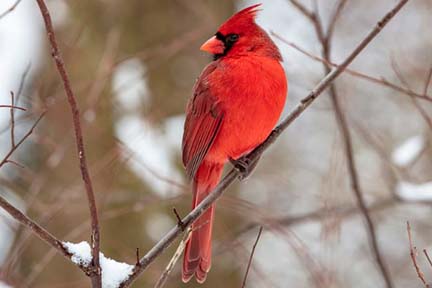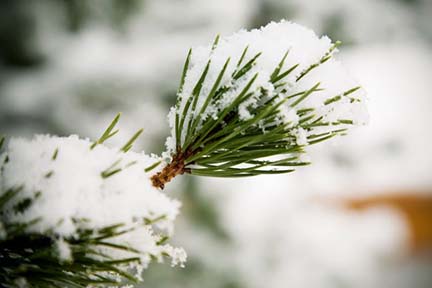| Here are a few of this week’s stories from the Michigan Department of Natural Resources:
See other news releases, Showcasing the DNR stories, photos and other resources at Michigan.gov/DNRPressRoom.
PHOTOS: Larger, high-res versions of some of the images used in this email (winter trail, pine grosbeak, white-breasted nuthatch, Nature Awaits), and others (coyote), are available in the DNR’s public image gallery.
 Bird feeders can support Great Lakes birds when natural food sources may be scarce or buried beneath snow and during migration come spring, but it’s essential to follow safety tips to keep them healthy and prevent the spread of highly pathogenic avian influenza and other diseases. Bird feeders can support Great Lakes birds when natural food sources may be scarce or buried beneath snow and during migration come spring, but it’s essential to follow safety tips to keep them healthy and prevent the spread of highly pathogenic avian influenza and other diseases.
To feed or not to feed
While most backyard birds are at low risk of HPAI, the virus is present in some wild bird populations in the Great Lakes. Positive HPAI cases have been documented in commercial flocks, backyard flocks, dairy cattle, wild birds and wild mammals, according to the U.S. Department of Agriculture. Most cases occur in waterfowl and scavengers like eagles, hawks and owls, but other wild birds, including shorebirds and gulls, can harbor the virus.
Since December, there has been an uptick in HPAI wild bird deaths, primarily in Canada geese, trumpeter swans and scavenging birds. HPAI is shed – or released via viral particles – through feces, saliva and nasal discharges. Though some human cases have been reported, the general population’s risk remains low.
In Michigan, you can still feed your backyard birds, but wildlife experts urge you to keep birds safe with some simple steps.

Do:
- Report observations of six or more dead birds using the DNR’s Eyes in Field reporting form or calling the DNR Wildlife Disease Laboratory at 517-336-5030.
- Clean bird feeders every one-two weeks in a 9:1 solution of water and bleach, scrubbing away any debris.
- Wear gloves while cleaning feeders and thoroughly wash hands when finished.
- Let feeders dry fully before refilling.
- Fence in your feeders, if possible, to prevent deer access and reduce the risk of chronic wasting disease.
- Remove and disinfect feeders if sick or dead birds are found.
Don’t:
- Handle or attempt to capture sick or dead birds.
- Let your pets near bird carcasses.
- Place seed directly on the ground or use platform feeders, which attract large numbers of birds, deer and rodents.
- Feed wild birds if you have backyard poultry.
Visit Michigan DNR’s HPAI Frequently Asked Questions page to learn more about the virus and how you can help keep Michigan’s birds safe.
Learn more about Michigan birds and backyard bird feeding tips at MI Birds, a public outreach and education program created by Audubon Great Lakes and the DNR. MI Birds engages Michiganders in caring for public lands vital to birds and communities. |
Questions? Contact DNR wildlife pathologist Julie Melotti at 517-243-1953
 Whether you are hoping to dip your toes into a new field, seeking a summer gig or ready to share years of comprehensive experience, the DNR has job opportunities available throughout the state. Whether you are hoping to dip your toes into a new field, seeking a summer gig or ready to share years of comprehensive experience, the DNR has job opportunities available throughout the state.
This spring, we’re looking for:
For many, working with the DNR is a unique and rewarding experience. Whether the duties are in an office, in the field or on the water, it’s about helping people connect with and enjoy our state’s natural resources and outdoor stories! Get a glimpse of several DNR positions (including park interpreter and park ranger) in the Michigan DNR Careers video playlist.
All DNR jobs
In addition to these opportunities, there are postings for positions such as license sales technician, marketing strategist and fisheries census clerk. Visit Michigan.gov/DNRJobs for more information about these active DNR job openings, and check back often for updates. |
 Coyotes can be found statewide in just about any habitat, including urban and suburban neighborhoods. People often unintentionally create suitable habitat for adaptable wildlife like coyotes, foxes, rabbits, squirrels, deer, geese and turkeys, making it easier for these animals to expand beyond traditional wildlife habitat boundaries. Coyotes can be found statewide in just about any habitat, including urban and suburban neighborhoods. People often unintentionally create suitable habitat for adaptable wildlife like coyotes, foxes, rabbits, squirrels, deer, geese and turkeys, making it easier for these animals to expand beyond traditional wildlife habitat boundaries.
While coyotes are an integral part of our ecosystem, some residents may see them as a nuisance.
“If there’s an unwelcome coyote in the area, look for possible attractants that might make the area appealing,” said Rachel Lincoln, a wildlife outreach coordinator with the DNR Wildlife Division.
“Is there a nearby patch of woods or natural area that provides shelter? Are there food sources, such as bird feeders, that attract small mammals or an abundance of rabbits?” Lincoln said. “Where possible, modify or remove the things that are attracting coyotes or the small mammals they prey on.”
It could be as simple as removing bird feeders and keeping trash cans indoors until the morning of trash pickup. This short video on “hazing” tactics provides ideas you can try to help maintain coyotes’ natural fear of people and reduce opportunities for coyotes or other animals to get used to finding ready food sources. |
 “You want to make it uncomfortable and unpleasant for the coyote to be near people,” said Lincoln. “Coyotes that become accustomed to being around people may become bolder as their fear lessens. It’s good to remind them that people should be avoided.” “You want to make it uncomfortable and unpleasant for the coyote to be near people,” said Lincoln. “Coyotes that become accustomed to being around people may become bolder as their fear lessens. It’s good to remind them that people should be avoided.”
If you’ve tried these tactics but coyotes still hang around your property, or you’re concerned about their presence in the area, contact a nuisance wildlife control business for help. These businesses are permitted by the DNR to remove certain wildlife, including coyotes, from private property.
If hunting is allowed in your area, coyote hunting and trapping seasons are available statewide. Check local laws and review the statewide hunting and trapping regulations for coyotes in the current Furbearer Harvest Regulations Summary at Michigan.gov/Trapping.
Learn more about coyotes and how to handle conflicts with wildlife at Michigan.gov/Wildlife.
Questions? Contact the DNR Wildlife Division at 517-284-9453. |
 See more pictures by Michigan state parks photo ambassadors at Instagram.com/MiStateParks. For more on the program, call Stephanie Yancer at 989-274-6182. (This photo is by Ashish Phansalkar, for the Michigan DNR, at Mackinac Island State Harbor.) See more pictures by Michigan state parks photo ambassadors at Instagram.com/MiStateParks. For more on the program, call Stephanie Yancer at 989-274-6182. (This photo is by Ashish Phansalkar, for the Michigan DNR, at Mackinac Island State Harbor.)
|










 Bird feeders can support Great Lakes birds when natural food sources may be scarce or buried beneath snow and during migration come spring, but it’s essential to follow safety tips to keep them healthy and prevent the spread of highly pathogenic avian influenza and other diseases.
Bird feeders can support Great Lakes birds when natural food sources may be scarce or buried beneath snow and during migration come spring, but it’s essential to follow safety tips to keep them healthy and prevent the spread of highly pathogenic avian influenza and other diseases.
 Whether you are hoping to dip your toes into a new field, seeking a summer gig or ready to share years of comprehensive experience, the DNR has job opportunities available throughout the state.
Whether you are hoping to dip your toes into a new field, seeking a summer gig or ready to share years of comprehensive experience, the DNR has job opportunities available throughout the state.
 Coyotes can be found statewide in just about any habitat, including urban and suburban neighborhoods. People often unintentionally create suitable habitat for adaptable wildlife like coyotes, foxes, rabbits, squirrels, deer, geese and turkeys, making it easier for these animals to expand beyond traditional wildlife habitat boundaries.
Coyotes can be found statewide in just about any habitat, including urban and suburban neighborhoods. People often unintentionally create suitable habitat for adaptable wildlife like coyotes, foxes, rabbits, squirrels, deer, geese and turkeys, making it easier for these animals to expand beyond traditional wildlife habitat boundaries.
 “You want to make it uncomfortable and unpleasant for the coyote to be near people,” said Lincoln. “Coyotes that become accustomed to being around people may become bolder as their fear lessens. It’s good to remind them that people should be avoided.”
“You want to make it uncomfortable and unpleasant for the coyote to be near people,” said Lincoln. “Coyotes that become accustomed to being around people may become bolder as their fear lessens. It’s good to remind them that people should be avoided.”
 See more pictures by
See more pictures by 

